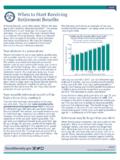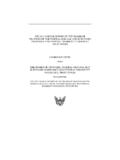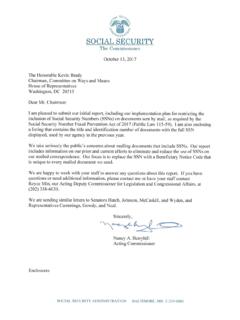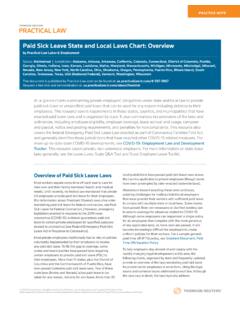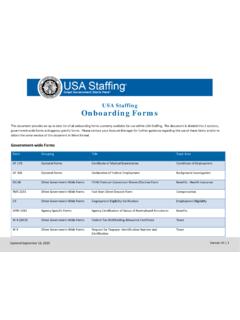Transcription of Private Health Insurance in the United States: An Overview
1 Private Health Insurance in the United Sta tes: An Overview Each December the Bulletin hns published a summary article presenting data on Private con- sumer expend&wes for medical care and on the financing of Health Insurance organiza- tions. This year the material on Health irwurance and expenditures has been reorganized. Two articles instead of one will be presented. The first, which upyears below, deals exclusively with Private Health Insurance . It continues the series on j;nnncex and adds a new series on enrollment.
2 The second article, ,zohich will appear in the Bulletin for January 1966, ~roill present data on total national Health expenditures, public and Private , giving n?z overnU picture by type of sew- ice and sources of funds. The article ,wilZ include data, formerly appeuring in the December issue, ML* prkte co%wmer medical expenditures and the proportion of SUCJL expenditures being covered by colwntary Jtealth Insurance . WITH THE INTRODUCTION of a public pro- gram of Health Insurance for the aged, it is appropriate to review and take stock of the devel- opment and accomplishments of the Private Health Insurance movement.
3 Private Health in- surance plans now provide some measure of Health protection to more than 4 out of 5 persons mlder age 65. This article reviews the develop- ment of Health Insurance in this comltry, describes the various types of Health Insurance organiza- tions, and gives data on enrollment, and finances. History Ahhough the main development of Health Insurance in this country began in the 1930 s, organizations of varying t,ypes had begun to make arrangements for prepayment of medical care as early as the middle of t,he last century.
4 Among the earliest plans were the hospit,al associat~ions developed by the railroads, par- *Office of Research and Statistics, BULLETIN, DECEMBER 1965 by LOUIS S. REED* titularly those serving the West. Many of the railroad companies served unsettled country and had to build their own hospitals and employ phy- sicians to assure that care would be available for sick or injured employees. To finance the care, the companies organized hospital associations, which provided comprehensive care to employees in return for fixed periodic payments deducted from pay.
5 The Southern Pacific organized its association in 1869, the Missouri Pacific in 1876, the Northern Pacific in 1881-to cite the earlier ones. In 1930, there mere 2 7 st,eam railroads with hospital associations or relief departments that, provided medical care to more than 500,000 employees. ,4bout the same time, various companies in the logging, coal, and metal mining industries devel- oped similar arrangements. Frequently, because of the isolation of the enterprise, these plans were the only way of assuring that hospital facili- ties and doctors would be available.
6 By 1930, about 540,000 mining and lumber employees were covered by payroll deduction medical service plans of one type or Similar medical care prepayment arrangements were developed by various concerns or employee benefit associations in the textile, steel, and other industries. In the 1920 s a number of Private group medical clinics-such as the Ross-Loos plan in California-made arrangements to serve groups of patients on a prepayment basis. A few hospitals here and there developed similar arrangements. Commercial accident and Health Insurance was first written in the United St,ates in 1847, largely in the form of accident Insurance .
7 Later, this protection was extended to cover disability caused by sickness, and some companies added provisions for reimbursement of medical care expenses. Such benefits were relatively unimportant, however, in comparison with the cash disability or accident 1 Pierce Williams. Ncr7icaZ Care Tkrough Fixed Per- iodic Paumotts, National Bureau of Economic Research, 19332, page 4. 2 Ibid., page 3. 3 benefits , representing less than 10 percent of the $200 million in benefits paid under all accident and Health Insurance in ,411 told, by 1930 probably about 1112 million or 2 million persons were covered under medical pre- payment or Health Insurance arrangements.
8 BLUE CROSS AND BLUE SHIELD PLANS The beginnings of the Blue Cross plans are usually traced to an experiment of the Baylor University Hospital in Texas in 1929. The school teachers of L)allas asked the hospital if it could provide them with hospital care on a prepayment basis. The hospital evolved a plan mlder which each teacher would be eligible for 3 weeks of hospital care in return for a payment of $3 a semester or $6 a year. The experiment. was successful, and soon other employee groups in the city requested similar privileges.
9 In the early 1930 s, with the deepening of the depression, charity cases increased and income from paying patients declined. Hospitals through- out, the country began to pay attention to the Baylor plan and to consider starting similar plans. It was soon apparent that there would be many problems if each hospital operated its own plan, in competition with other hospitals, and that it would be far better if all the hospitals of a community could get together and jointly offer a plan. Soon plans of this nature, offering free choice among the participating hospitals, made their appearance.
10 The first citywide plan was that offered by the hospitals of Sacramento, California, in *July 1932. Then in January 1933 the hospitals of Newark, New jersey , started a plan, and in July 1933, those of St. Paul, Minnesota. Most, of the earlier plans initially were set up to serve a city or a metropolitan area and later expanded to serve the entire State. There were 10 plans with 54,000 participants at the end of 1934, 26 plans with 600,000 participants by the end of 1936, and 59 plans with more than 4 million participants by the end of 1939.
